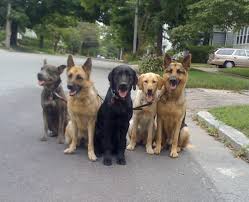
You shouldn’t have to deal with dogfights in your home!
Because dogs are pack animals, we have high expectations about their abilities to live peacefully in groups. If you are a human member of a multi dog household, it is important to be realistic about what you can and cannot accomplish with your canine family members. Your own personality, behavior, commitment to managing and training your pack, as well as your choice of pack mates, will all play important roles in your ability to create your own peaceful kingdom.

It’s in the genes
Once upon a time, our dog’s ancestors were all wild and lived in packs. It was critically important to pack survival that they get along well with each other. Even a minor injury from an aggressive pack mate’s tooth could become infected and cause the disability and death of a pack member.
Wild dogs depended on the abilities of the whole canine family to help with hunting and pack defense-a disabled member was a liability to all. For these survival reasons, dogs developed a highly ritualized language that enabled them to maintain pack order without bloodshed. Meaningful eye and facial expression, body posture, snapping, snarling, and even tooth contact without enough pressure to break skin all contributed to harmonious pack life.
Enter the human. Over the centuries, as we molded the canine species exceptionally plastic phenotype, we created breeds such as Beagles, Bassets, Foxhounds, Coonhounds, Labradors, Golden Retrievers and others-the hounds and sporting breeds that still have very strong genes for pack harmony. At the opposite extreme, we also created breeds such as the American Pit Bull Terrier, that genetically have very little tolerance for the proximity of others of their kind.
If you are just starting out on your path to pack life, your shortest route to a peaceful pack is to select canine family members from the harmonious end of the scale, and avoid the pugnacious fighting breeds and feisty terriers, and obsessive herding dog types. That’s not to say that some Pit Bulls , Scottish terriers, and Australian kelpies can’t live in group homes-they certainly can-it just takes more effort on the part of the human to make it work.
 Order In the Pack
Order In the Pack
Pack management is as much an art as a skill. If you have always had a multi-dog household, never had problems, and never thought twice about it, congratulations! You are one of the lucky ones-a natural. You probably instinctively have done all the right things to help your pack be well adjusted. Many dog owners aren’t as fortunate.
Pack problems run the continuum from simple delinquent behaviors to serious intra-pack aggression. While many dog owners tolerate the former, group bad manners is often the precursor to aggression, and is far more easily addressed before canine emotions escalate to the blood letting level.
The basic tenet for a successful multi-dog household is simple: The more dogs in the home, the more “in charge” the human pack member must be.The “in charge” tenet for pack management is closely followed by this corollary: The more dogs in the household, the more well trained and well behaved the canine members of the pack must be. So how does a floundering human leader restore order to the pack?
The first step is management. If you are facing pack behavior challenges, start by identifying the key areas of conflict, so you can figure out how to put a management plan in place while you work on long term training solutions.
Conflicts…
A sample list of common conflict situations might look something like the following. We’ll call our sample dog guardian, Jane and describe representative personalities of various players in her pack.
 Feeding Time
Feeding Time
Angel devours her food then runs over to eat Sweetie’s, which sometimes starts a fight. Meanwhile, Sugar tries to pick up her food bowl and carry it under the sideboard, often spilling it in the process. Honey wolfs down her food, growling and making evil faces all the while.
Going Outside
All four dogs jostle for position at the door, accompanied by snapping and growling, and an occasional full on battle. Jane has been bitten many times trying to maintain order at the door while restraining Angel by the collar.
 Watching TV
Watching TV
Jane’s house routine is to eat dinner on the coffee table while watching TV. Dogs all vie for the closest spot to catch dropped crumbs and hand fed tidbits. Fights most often occur between Angel and Honey.
 Playing
Playing
Sugar and Sweetie love to roughhouse together, biting and chewing on each other. All goes well for some time, but Jane can see their energy level rise as they play, three out of five times it ends in a fight.
 Getting Home from Work
Getting Home from Work
All the dogs are very excited when Jane walks in the door after a long day at work. She is happy to see them too, so she greets them effusively, in a high pitched voice, with lots of hugs and kisses. Occasionally, in the excitement Honey turns on Angel and pins her to the ground.
 Bedtime
Bedtime
Sugar has claimed the human bed as her own, and that’s okay with Jane, she’s willing to share. The others usually work out who gets which dog bed on the floor with only minor grumbling, but Honey will sometimes test Sugar’s claim and jump up to join Jane and Sugar, to the tune of much snapping and snarling.
Diagnosis: Stress!
Aggression is caused by stress, and there is plenty of it in Jane’s pack. Jane is obviously not ” a natural”. She knows she has a problem-if she has any doubts, the $800.00 vet bill for the last incident between Angel and Honey erased them.
She has tried to control her rowdy family members, but failed miserably. On the advise of a well meaning friend she was letting the dog’s work it out by themselves, but things have only gotten seriously worse. She read a book that suggested supporting the Alpha Dog. As best she can tell, Honey is top dog in the pack, so she feeds Honey first, tries to let her out the door first, and lets her sit by her while she eats dinner and feeds her treats. If a fight happens, she yells to break it up, then puts the other dogs out in the yard but lets Honey stay in, to support her position in the pack.
Jane needs a whole new approach to pack management. As the benevolent leader, she needs to decide what dog behavior is appropriate, not Honey. Order is best restored through calm management and positive training, not yelling and punishment.
And Solutions:
Here are management and training suggestions for each of Jane’s trouble spots.
Feeding Time: Feed the dogs separately, either in different rooms, in opposite corners of the same room, in crates, or by letting them come in one at a time to eat. Doors and baby gates can keep dogs confined to their separate rooms, while crates or tethers can allow them to eat safely in opposite corners of the same room. Eventually, after the dogs are trained to “Leave It” Jane may be able to referee feeding time without having to physically restrain the dogs.
Going Out
The “wait” exercise is exceptionally useful in maintaining peace at doorways with groups of dogs. Until she has taught her pack members to “wait”, Jane can use baby gates or tethers to restrain two or three of the dogs while letting them out one or two at a time to reduce the excitement and arousal that leads to aggression.
Once Jane has taught each of the dogs to wait at door she can start practicing with them two at a time, then three, then all four. The pack should learn to be released from the wait one at a time so there’s no door jam, and Jane should vary the order in which she releases them so they don’t learn to anticipate the release.
Watching TV
Jane is setting her dogs up for conflict by feeding them from her plate. She needs to stop this practice. She can use tethers to keep the dogs safely separated, comfortable on their own beds, while she eats dinner at the coffee table. She can eventually teach them to go to their designated beds on cue (place command) by rewarding them generously while their there. Chances are good that with time and practice, they will go to and stay on their beds when asked, without being tethered.
Playing
It’s good that Jane can see the energy level rising between Sugar and Sweetie, because that enables her to step in calmly and break up the play session before it turns ugly. She can tether or crate the playmates for several minutes to give the arousal time to subside, and then release them to play together again-no harm, no foul.
In time, Sugar and Sweetie may figure out that too much excitement makes the fun stop, and learn to better control their energy. Jane’s intervention needs to be calm and cool, if she yells, punishes, or moves too quickly, she is likely to escalate the energy between dogs and actually trigger a fight.
Getting Home from Work
Jane adds fuel to the fire with her excited homecomings, after a day spent inside, and a few hours of anticipating her return, the dogs are already keyed up. The joyous greeting is too stimulating, and the dog’s responses boil over.
Jane can manage her dog’s greeting behavior while she does long term training by crating the dog’s in her absence, assuming she won’t be gone longer than the dogs can tolerate. For pups, a good rule of thumb is one hour longer than the pups age in months-four hours for a 3 month old pup, etc. Adult dogs shouldn’t be routinely crated for longer than about 8 hours a stretch.
When Jane comes home, she can let the dogs out one at a time and greet them calmly. If they get charged up she can just quietly turn her back and walk away from them, or even turn and walk out the door. She can also start entering the house without greeting the dogs, ignoring them completely until they calm down. Once again, this teaches the dogs to control their own behavior, rather than submitting to her forcibly imposed will. Chances are good that if she does not feed the energy, they will settle quickly and fights won’t happen.
Bedtime
One word-crates! I am not opposed to dogs sleeping on the bed, unless dogs on the bed is causing problems, which in Jane’s case it clearly is. She is at risk of injury herself, lying on her bed beneath 2 squabbling canines.
She could start by crating all the dogs at night, then, if her ultimate goal is to have them un crated at night, experiment with letting one out, then two, and as long as good manners hold, eventually all four. Any nighttime growling or snapping is grounds for a renewal of crating.
Of course, while Jane effectively manages her dog’s behavior in the home, we also expect her to enroll in a good, positive training classes. Typically, group classes at your local kennel club work best. Try to avoid taking training classes at your local chain pet store. These trainers typically have minimal hands on training experience. She may not be “a natural” but she can learn. Her class instructor will be a valuable resource to her in identifying and resolving her dog’s pack behavior challenges.
It will take time for Jane to complete basic classes with each of the four dogs, but the improvement in her communication with the understanding of their behaviors and thought processes will well be worth the effort. In fact, it will be the ultimate key to her long term success in turning her home into a peaceful kingdom, and ensuring that she enjoys mutually rewarding lifelong relationships with each member of her pack.
The Whole Dog Journal






